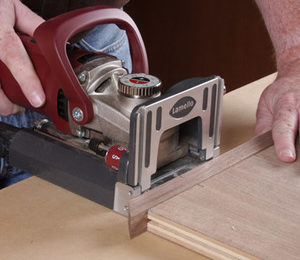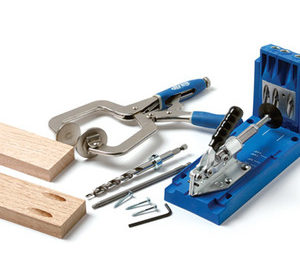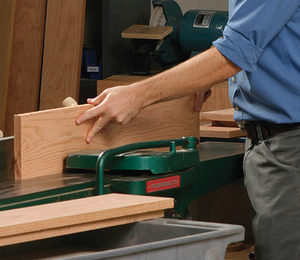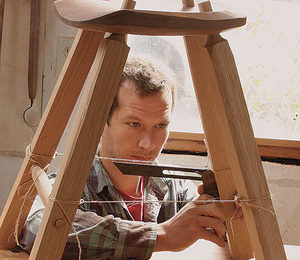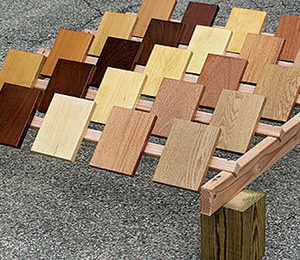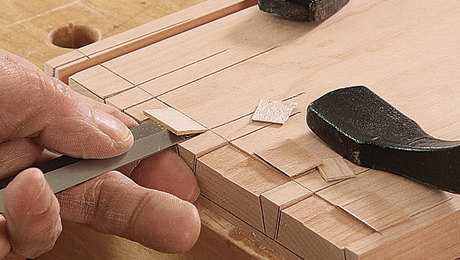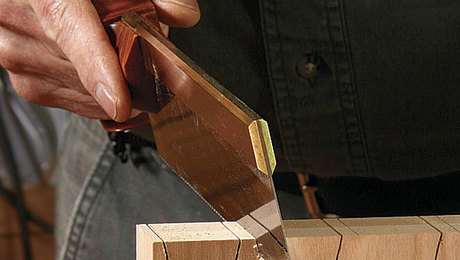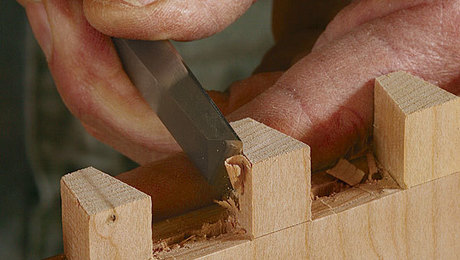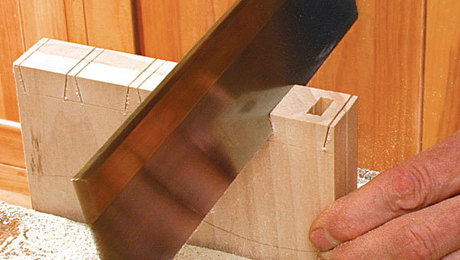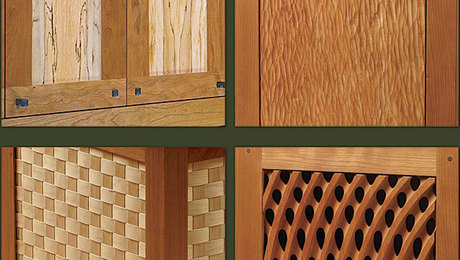Fri, 20 December 2019
This episode is brought to you by Maverick Abrasives. https://www.maverickabrasives.com/ Check out the lineup for this year's Fine Woodworking Live here - https://:www.finewoodworkinglive.com Links from this episode can be found here - https://www.shoptalklive.com Sign up for the Fine Woodworking weekly eLetter - https://www.finewooworking.com/newsletter Sign up for a Fine Woodworking Unlimited membership - https://www.finewoodworking.com/unlimited Shop Talk Live show notes are available here - https://www.shoptalklive.com Become an UNLIMITED member today and get instant access to all FineWoodworking.com content. Start your free two week trial here: http://bit.ly/2m576Fl For more Shop Talk Live or to submit a question: http://bit.ly/2mVJYd0 To see the newest issue of Fine Woodworking: http://bit.ly/2newDLh |
||||||||||||||||||||
Fri, 6 December 2019
This episode is brought to you by Maverick Abrasives. https://www.maverickabrasives.com/ Check out the lineup for this year's Fine Woodworking Live here - https://:www.finewoodworkinglive.com Links from this episode can be found here - https://www.shoptalklive.com Sign up for the Fine Woodworking weekly eLetter - https://www.finewooworking.com/newsletter Sign up for a Fine Woodworking Unlimited membership - https://www.finewoodworking.com/unlimited To see the newest issue of Fine Woodworking: http://bit.ly/2newDLh |
||||||||||||||||||||
Fri, 22 November 2019
This episode is brought to you by Maverick Abrasives. https://www.maverickabrasives.com/ Check out the lineup for this year's Fine Woodworking Live here - https://:www.finewoodworkinglive.com Links from this episode can be found here: https://www.shoptalklive.com Sign up for the Fine Woodworking weekly eLetter - https://www.finewooworking.com/newsletter Sign up for a Fine Woodworking Unlimited membership - https://www.finewoodworking.com/unlimited Shop Talk Live show notes are available here - https://www.shoptalklive.com Become an UNLIMITED member today and get instant access to all FineWoodworking.com content. Start your free two week trial here: http://bit.ly/2m576Fl For more Shop Talk Live or to submit a question: http://bit.ly/2mVJYd0 To see the newest issue of Fine Woodworking: http://bit.ly/2newDLh |
||||||||||||||||||||
Fri, 8 November 2019
This episode is brought to you by Maverick Abrasives. https://www.maverickabrasives.com/ Check out the lineup for this year's Fine Woodworking Live here - https://:www.finewoodworkinglive.com This episode's poll, shop-music playlists and links can be found here - https://www.shoptalklive.com Sign up for the Fine Woodworking weekly eLetter - https://www.finewooworking.com/newsletter Sign up for a Fine Woodworking Unlimited membership - https://www.finewoodworking.com/unlimited Shop Talk Live show notes are available here - https://www.shoptalklive.com Become an UNLIMITED member today and get instant access to all FineWoodworking.com content. Start your free two week trial here: http://bit.ly/2m576Fl For more Shop Talk Live or to submit a question: http://bit.ly/2mVJYd0 To see the newest issue of Fine Woodworking: http://bit.ly/2newDLh |
||||||||||||||||||||
Fri, 25 October 2019
This episode is brought to you by Maverick Abrasives. Sign up for the Fine Woodworking weekly eLetter - https://www.finewooworking.com/newsletter Sign up for a Fine Woodworking Unlimited membership - https://www.finewoodworking.com/unlimited Shop Talk Live show notes are available here - https://www.shoptalklive.com |
||||||||||||||||||||
Fri, 11 October 2019
The North Jersey Woodworkers Association or NJWA for short is a community of woodworkers of all types and levels of experience. We have some professionals, some beginners and every skill level in between. Our goal is to share our experience with one another and to support and grow the woodworking community in the Northern New Jersey area. Regardless of woodworking interest or level of experience, we invite you to join us. For directions, membership information and club activities follow this link: About NJWA. |
||||||||||||||||||||
Fri, 27 September 2019
Sign up for the Fine Woodworking weekly eLetter - https://www.finewooworking.com/newsletter Sign up for a Fine Woodworking Unlimited membership - https://www.finewoodworking.com/unlimited Shop Talk Live show notes are available here - https://www.shoptalklive.com
|
||||||||||||||||||||
Fri, 20 September 2019
Tim's Modern Desk video workshop: https://www.finewoodworking.com/videoworkshop/2019/07/danish-modern-desk-with-tim-rousseau Sign up for the Fine Woodworking weekly eLetter - https://www.finewooworking.com/newsletter Sign up for a Fine Woodworking Unlimited membership - https://www.finewoodworking.com/unlimited Shop Talk Live show notes are available here - https://www.shoptalklive.com |
||||||||||||||||||||
Fri, 13 September 2019
John, Barry, and Ben discuss workbench stretchers, basement shop vs. garage shop, and a new chapter begins in the round vs. square mortise debate Sign up for the Fine Woodworking weekly eLetter. Sign up for a Fine Woodworking Unlimited membership. Shop Talk Live show notes are available here. |
||||||||||||||||||||
Fri, 30 August 2019
Question 1: From Elijah:
Question 2: From Reg:
Segment: All-Time Favorite Tool Mike: Holdfast Ben: CNC used as a pin router Anissa: Her marking gauges
Question 3: From Dave:
Question 4: From Frank: Every two weeks, a team of Fine Woodworking staffers answers questions from readers on Shop Talk Live, Fine Woodworking‘s biweekly podcast. Send your woodworking questions to shoptalk@taunton.com for consideration in the regular broadcast! Our continued existence relies upon listener support. So if you enjoy the show, be sure to leave us a five-star rating and maybe even a nice comment on our iTunes page. |
||||||||||||||||||||
Fri, 16 August 2019
Question 1: From Chase: I have an old 13" hitachi planer I got from craigslist many years ago. It has served me well but is starting to have issues. 13 inches has been useful, but at times I wish it was wider. In your experience is it worth the extra money to buy something bigger, or should I stick with a more reasonable choice like DW735? I have 220v access and floor space, so that isn't an issue. I am in my 30s, have been woodworking for ~10 years. I would like to keep woodworking into my 80s, so I can justify a longer term investment. I can afford a 1.5 or 2k tool, but could buy something else if I stuck with a cheaper planer.
Question 2: From Martin: I know Mike likes to have a small offset between the rails and stiles of his frame-and-panel doors. But how does he then avoid chipping the unsupported inside corners of the stiles when planing the top and bottom of the door to fit the opening?
Segment: All Time Favorite Tool of All Time Barry: SketchUp Mike: Suizan Japanese Saws and DFM Dowel Plate Ben: Shopmade Hot Pipe Bender
Question 3: From RobGoSlow on YouTube: I'm not sure where to submit questions for the podcast but I have one: I'm a very new wood worker with a lower end contractor table saw. Obviously things like the blade angle and fence are not very precise but I want to know what sources of error are there to look out for? What are the types of error you're concerned about with a cheap table saw?
Question 4: From Capt. Zachary J. Daniels: I want to buy a block plane from Lie-Nielsen. I know Mike is a fan of the adjustable mouth block plane. However, I also remember Mike and Matt Kenney having a spirited debate where Matt was extolling the virtues of the rabbeting block plane. I can’t seem to find the original discussion between Matt and Mike. Instead of listening to the entire catalog again, (and without Matt around to defend himself) I’m interested to hear Mike’s opinion on why he prefers the adjustable mouth block plane over the rabbeting block plane. Right now, I only want to buy one block plane as I also have my eye on the No. 62 low angle jack. Thanks for the show and keep up the great work! I became an unlimited member after listening to several of the podcasts, so keep the content coming and inspiring others!
Every two weeks, a team of Fine Woodworking staffers answers questions from readers on Shop Talk Live, Fine Woodworking‘s biweekly podcast. Send your woodworking questions to shoptalk@taunton.com for consideration in the regular broadcast! Our continued existence relies upon listener support. So if you enjoy the show, be sure to leave us a five-star rating and maybe even a nice comment on our iTunes page.
|
||||||||||||||||||||
Fri, 9 August 2019
For more than 25 years GreenWood has worked with artisans in Honduras and the Peruvian Amazon to produce high-quality wood products from well-managed forests. They train woodworkers to use appropriate tools and technologies, and connect their products to good markets. The GreenWood Carver's Mallets are available at LeeValley.com. Support GreenWood's efforts by heading over to their GoFundMe page. |
||||||||||||||||||||
Fri, 2 August 2019
Rollie Johnson and Justin Fink join Tom, Barry, and Ben to discuss new tools being shown at the AWFS fair in Las Vegas |
||||||||||||||||||||
Thu, 18 July 2019
Danish Modern Desk with Tim Rousseau Question 1: From Devin: Question 2: From the Fine Woodworking forum by forum member NewAndGreen: Question 3: Also from Paul:
Price of Osmo Polyx Oil at time of broadcast: .75-Liter=$58.56 Segment: All-Time Favorite Technique of All Time Mike: Tom McLaughlin’s “cut some off and glue it on the other side” technique Anissa: Steve Latta’s hinged flips stop Ben: Using metal files to shape difficult woods Question 4: From Brendan: And from Paul:
Recommendations: Anissa - Ted Talk - Rives: The Museum of Four in the Morning
Every two weeks, a team of Fine Woodworking staffers answers questions from readers on Shop Talk Live, Fine Woodworking‘s biweekly podcast. Send your woodworking questions to shoptalk@taunton.com for consideration in the regular broadcast! Our continued existence relies upon listener support. So if you enjoy the show, be sure to leave us a five-star rating and maybe even a nice comment on our iTunes page.
|
||||||||||||||||||||
Fri, 5 July 2019
Start Woodworking Season 1 by Matt Berger, Asa Christiana https://www.finewoodworking.com/videoworkshop/2019/07/start-woodworking-season-1 Question 1: From Dan: I recently built a pair of desks featured in issue #270. I built them mostly the way Michael Robbins did, however instead of using a domino to construct the top I used pocket screws. I don't own a domino, I opted for a hollow chisel mortiser, and I thought it would be silly to use a hollow chisel mortise. How do you feel about pocket screws versus slip tenons made with a domino? Both tools make joining pieces of wood much simpler. One uses screws, the other uses wood and glue. One is under $100, and the other is over $1000. They are both faster and easier than traditional joinery. Am I wrong to think if I am not going to use traditional joinery pocket screws and domino slip tenons are interchangeable? I love my hollow-chisel mortiser, and if I'm gonna cheat on it, I’ll just use screws.
Question 2: From Chase: I was trying to edge-joint two 10-ft. long boards to make a wide shelf for our closet using a #7 handplane. Typically, I clamp the boards together and plane the common glue edge until I get an even shaving across both. I think that the length of the two boards meant there was some variation that the #7 didn't get. I can't imagine trying to joint these on a jointer, even if I had one. How would you go about making this glue up work?
Segment: All-time favorite tool of all time… for this week Mike: An Exacto knife with a brand new blade Asa: Cordless Trim Routers Ben: James Mursell Travisher (@windsorworkshop)
Question 3: From Chad, I was just listening to episode 190, and a listener asked about which big tool to buy next, a combo planer/jointer or a band saw. I've heard similar questions on the show before. I'm curious as to why you never mention the idea of investing in a makerspace, shared shop, or tool library? There are a lot of great examples of makerspaces that give access to fully stocked wood and metal shops for a reasonable membership fee as well as not-for-profit tool libraries that are usually state funded just like normal libraries that allow for the borrowing of tools like books! For someone who's just getting started in woodworking getting access to a full woodshop for a membership fee that wouldn't be enough to buy a single quality power tool might be worth considering! Maker Spaces: Tool Libraries: Question 4: From David: I am planning to build some outdoor chairs out of mahogany, and was wondering what finish to apply. I would like something that I don't have to touch up every year. Or, should leave them unfinished. How does mahogany age in the weather?
Recommendations: Ben - YouTube Channel: arboristBlairGlenn Every two weeks, a team of Fine Woodworking staffers answers questions from readers on Shop Talk Live, Fine Woodworking‘s biweekly podcast. Send your woodworking questions to shoptalk@taunton.com for consideration in the regular broadcast! Our continued existence relies upon listener support. So if you enjoy the show, be sure to leave us a five-star rating and maybe even a nice comment on our iTunes page.
|
||||||||||||||||||||
Fri, 21 June 2019
Dovetailing episodes from Chris Gochnour's Enfiled Cupboard Video Workshop:
Video: Chris Becksvoort–The Dovetail Master Question 1: Question 2: Question 3:
Segment: All-Time Favorite Technique
Question 4: Question 5: Question 6:
Recommendations: Barry - Get a camelback for hiking Ben - Yeti 18-oz. Rambler Bottle with MagDock Cap |
||||||||||||||||||||
Fri, 7 June 2019
If you are interested in learning more about how you can support Old Sturbridge Village’s cabinet shop, contact their development office at development@osv.org for more information. Question 1: From Joseph:
Question 2: From Nick:
Segment: All-Time Favorite Technique
Ben: Drawing an extra line when sawing on the left side of your layout line Question 3: From Jim: Recommendations: Ben - Sharpen your marking gauge, because you know it's dull Every two weeks, a team of Fine Woodworking staffers answers questions from readers on Shop Talk Live, Fine Woodworking‘s biweekly podcast. Send your woodworking questions to shoptalk@taunton.com for consideration in the regular broadcast! Our continued existence relies upon listener support. So if you enjoy the show, be sure to leave us a five-star rating and maybe even a nice comment on our iTunes page. |
||||||||||||||||||||
Fri, 24 May 2019
Become a Fine Woodworking Unlimited member today and get instant access to all FineWoodworking.com content. Start your free two week trial here. Question 1: From Tom: Question 2: From Richard:
Segment: Smooth Move Ben: Drilling a depth-indication hole on the wrong side. Question 3: From Jesse: Recommendations: Ben - Prismacolor Premier Pencil Sharpener Every two weeks, a team of Fine Woodworking staffers answers questions from readers on Shop Talk Live, Fine Woodworking‘s biweekly podcast. Send your woodworking questions to shoptalk@taunton.com for consideration in the regular broadcast! Our continued existence relies upon listener support. So if you enjoy the show, be sure to leave us a five-star rating and maybe even a nice comment on our iTunes page. |
||||||||||||||||||||
Fri, 10 May 2019
Guest 1: Joe Taylor - Director of Sales for Rikon Joe gave us the ins and outs of a few of Rikon's new products Model 10-326DVR: 14″ Deluxe Bandsaw with Smart Motor DVR Control
Guest 2: Nancy Hiller From Jim: In terms of their aesthetic value, is there a line for you between fine furniture and cabinetry? From Jeff: If you could only design, or build, which would it be and why?
Guest 3: Christian Becksvoort From Scott: What are your top five records at the moment? From Josh: What Shaker element do see reproduced poorly in modern versions of the classics? From Erick: What finish are you using on most of your pieces, polyurethane or oil? And why?
Guest 4: Vic Tesolin From Kevin: What aspects of woodworking do you see most newer students totally over think? From Steve: Awhile ago, you posted a video of a tattoo that had leaves representing your favorite woods to work with. For those of us who are crap at identifying tree leaves, what are your favorite woods to build with?
Every two weeks, a team of Fine Woodworking staffers answers questions from readers on Shop Talk Live, Fine Woodworking‘s biweekly podcast. Send your woodworking questions to shoptalk@taunton.com for consideration in the regular broadcast! Our continued existence relies upon listener support. So if you enjoy the show, be sure to leave us a five-star rating and maybe even a nice comment on our iTunes page. |
||||||||||||||||||||
Fri, 26 April 2019
Question 1: From Al: I am having some trouble laying out the pins and tales on the Wenge in the more traditional way, unlike what Mike shows. Wenge is extremely hard and not at all forgiving and the grain tends to be a problem in scribing the wood. Perhaps this is why he choose to do this with the table saw and router methods as shown on Rough Cut. Where can I get the table saw blade and the router bit to do it like Mike. He always has great ideas that are very valuable.
Question 2: From Madison: I was wondering how long it took Mike to build the tea box featured in magazine issue 269. Segment: Ben: Steam bending everything! Question 3: From Matt: How would someone go about preparing kumiko strips without a tablesaw or drum sander? Every two weeks, a team of Fine Woodworking staffers answers questions from readers on Shop Talk Live, Fine Woodworking‘s biweekly podcast. Send your woodworking questions to shoptalk@taunton.com for consideration in the regular broadcast! Our continued existence relies upon listener support. So if you enjoy the show, be sure to leave us a five-star rating and maybe even a nice comment on our iTunes page. |
||||||||||||||||||||
Fri, 12 April 2019
Question 1: From Paul: Heide Martin’s serving trays in the May/June 2018 are beautiful and I have since made a couple. My question is about keeping the bottom boards flat. I cut some walnut that had been air dried for probably 20 years. In an hour or two both boards cupped. I then sequentially tried wetting one side, wetting both sides, soaking in water, soaking in fabric softener, each time clamping the boards to keep them flat and leaving for days and days to dry out. None of these things worked and in the end I ended up using some walnut plywood instead. How do you folks keep wide, thin boards flat?
Question 2: From Richard: In reality we all have limited amount of shop time available. However, if the amount of time you could work on a project was not limited what one piece would you choose to make?
Segment: All-Time Favorite Technique Mike: Using pocket holes to quickly make and change full-size mockups Tom: Beveling an edge of a workpiece with a handplane Ben: Riding the back of the blade to start a cut on the edge of workpiece Question 3: From Mark: I have been building furniture full-time for just over a year. Is it legal and/or ethical to build something from the magazine or a video workshop and then sell it? For instance, if a client asks me to build 4 Adirondack chairs, my thought is build them loosely based on what I find at Fine Woodworking, vs. reinventing the wheel with my own design every-time. Question 4: From John: I was reading a FWW article by Steve Latta in issue #241 about draw-bored tenons where he said, “I make pins from riftsawn or quartersawn stock...”. If you’re making dowels, how can it possibly make any difference whatsoever if you use quartersawn or plain sawn boards? I still like Steve Latta, btw. Keep up the great work, see y’all at FWWlive! Every two weeks, a team of Fine Woodworking staffers answers questions from readers on Shop Talk Live, Fine Woodworking‘s biweekly podcast. Send your woodworking questions to shoptalk@taunton.com for consideration in the regular broadcast! Our continued existence relies upon listener support. So if you enjoy the show, be sure to leave us a five-star rating and maybe even a nice comment on our iTunes page. |
||||||||||||||||||||
Fri, 29 March 2019
Question 1: From Harry: How can I prevent Camellia from becoming all gummy. After letting a plane set for a few weeks that had been wiped down with Camellia Oil it was next to impossible to get the plane apart. I actually caused some minor damage it was stuck so hard. Rollie’s answer: On tools if you have areas that the oil is applied to that don’t see use it can build a bit, but not much and over a long period of time. A quick wipe with a bit of naphtha or acetone will clean it off. Those solvents are essential because they are fully volatile and won’t leave any oily residue, which mineral spirits will do. Question 2: From Mike: In in a couple months I will be building a house and I will be putting my shop in the basement. Currently I have a small shop, but in my new shop it will be large (about 25x35). Since I have this rare opportunity, I want to put power in the floor and dust collection the floor. Therefore, I have to decide where to put my tools and I will not be able to move them. Are there general guidelines on placement of tools? How far should a table saw be away from a wall? What about a bandsaw, how far from a wall or in the sides? Same question for a router table, jointer and thickness planer.
Segment: All-Time Favorite Technique Mike: Using a bendy stick to hold in moldings as you glue them Anissa: A Box Worth Repeating by Laura Mays #240–May/June 2014 Issue Ben: Using blue tape and CA glue as a stand-in for double-sided tape Mike’s double-down technique: Using a bendy ruler clamped in a pipe clamp as a curve bow Question 3: From Chris: Question 4: From Jim: Recommendations: Ben - StewMac’s YouTube Channel Every two weeks, a team of Fine Woodworking staffers answers questions from readers on Shop Talk Live, Fine Woodworking‘s biweekly podcast. Send your woodworking questions to shoptalk@taunton.com for consideration in the regular broadcast! Our continued existence relies upon listener support. So if you enjoy the show, be sure to leave us a five-star rating and maybe even a nice comment on our iTunes page. |
||||||||||||||||||||
Fri, 15 March 2019
Question 1: From Shawn: I’m working on a Christmas present for my sister. It’s a hallway table with 2 drawers in cherry. This is the first piece I’ve made with cherry. Some of the surfaces have a quarter sawn grain orientation and I’m finding them highly prone to tear out. My card scraper seems to be the only tool I’ve got that can tackle it, and even then I still have to pay really close attention to the changing grain direction. I’d like to hear any recommendations you might have about tools and techniques to deal with tear out, and also about other tear out prone woods you’ve worked with. I’ve found quarter sawn maple to be difficult as well.
Question 2: From Joe: To build a bed for my grandson I ordered 50 bd ft of rough lumber, Black walnut. The wood was beautiful but this is where my confusion began. I got the job done but I don't know if I went about it the best way. The bed with headboard, frame, 6 drawers underneath, and footboard had over 100 pieces. All the lumber was about 8 inches wide and about 10 feet long. Is it better to mill the long boards and then layout all the parts, or layout the parts oversize and cut them out and send smaller pieces through the planer and jointer? Segment: All-Time Favorite Tool Mike: 6-in. Combo Square Question 3: From Mike: I’ve come to realize my jointer needs tuning, and i recall you guys saying how you set your outfeed table a hair lower than your cutter head. I can’t find the episode that contains this discussion, but i don’t recall there being any reasoning for this. I adjusted mine as y’all suggested but found this was causing the trailing ends of the boards to not touch the blades. After reading my powermatic manual, it says to have the outfeed table level with blade, so what’s up with your hack causing me this grief? Recommendations:
Every two weeks, a team of Fine Woodworking staffers answers questions from readers on Shop Talk Live, Fine Woodworking‘s biweekly podcast. Send your woodworking questions to shoptalk@taunton.com for consideration in the regular broadcast! Our continued existence relies upon listener support. So if you enjoy the show, be sure to leave us a five-star rating and maybe even a nice comment on our iTunes page. |
||||||||||||||||||||
Fri, 8 March 2019
Chris Schwarz is a furniture maker and writer who works from a German barroom built in 1896 in Covington, Ky. He is one of the founders of Lost Art Press, a book-publishing company that specializes in handwork, and Crucible Tool, a company that makes hand tools for woodwork. Chris is the author of several books, including Workbenches: From Design & Theory to Construction & Use (F+W Media), The Anarchist’s Tool Chest, Campaign Furniture, The Anarchist’s Design Book and Ingenious Mechanics (Lost Art Press). In addition to his publishing efforts, he builds casework and Welsh stick chairs for clients all over the world. Chris' class at Fine Woodworking Live is titled: Compound-Angle Joinery, Minus the Math Register now for Fine Woodworking Live 2019! Enter for your chance to win Fine Woodworking's Shop Giveaway: Upgrade to Laguna! The winner will receive a prize that includes:
|
||||||||||||||||||||
Fri, 1 March 2019
Enter for your chance to win Fine Woodworking's Shop Giveaway: Upgrade to Laguna! The winner will receive a prize that includes:
Question 1: From William: I live in Ohio where the Emerald Ash Borer is ravaging every ash tree around. With all these ash trees coming down and the infestation of the Ash Borer, are we looking at a future shortage of ash trees? Should we, as woodworkers, stock up on quality ash boards while we can get them and while they're fairly inexpensive? Question 2: From Paul: I’ve started looking for a better sketchbook and am overwhelmed by the choices. I’ve heard Mike talk about the books he uses, but I’ve never heard him mention the brand or “model” he favors. On STL 155 he mentioned 60-80 lb paper, spiral bound, unruled, 6x9 size. Frankly, that limits it to about half a zillion options and it’s very hard to judge quality even touching the book at the local art supply place. So please spill, Mike! Segment: All-Time Favorite Tool
Question 3: From Caleb: I'm wondering if any of you have used a hollow chisel mortiser as a drill press? Is this a viable way to get around buying a drill press? Question 4: From Chris: What books inspire you to get out to your shop and build something? Any favorite books on the history of woodworking and maybe different trends through the ages? Or books specific to a style of working, like Shaker or arts & crafts, etc.? And from Larry: I would love to see a Live Talk episode on “go to books” reference books for novice woodworkers. Every two weeks, a team of Fine Woodworking staffers answers questions from readers on Shop Talk Live, Fine Woodworking‘s biweekly podcast. Send your woodworking questions to shoptalk@taunton.com for consideration in the regular broadcast! Our continued existence relies upon listener support. So if you enjoy the show, be sure to leave us a five-star rating and maybe even a nice comment on our iTunes page. |
||||||||||||||||||||
Fri, 15 February 2019
Leave a comment on this episodes show notes page to be entered in the giveaway of Craig Thibodeau's book, The Craft of Veneering. Peter Galbert’s FWW Live 2018 Keynote Speech - Unsurprisingly, the journey of a windsor chairmaker is rarely a straight line
Question 1: From David: I have avoided cordless power tools because as a hobbyist and renter, I seldom use the tools outside of the basement workshop. I've been told I don't know what I'm missing, but it seems my wallet prefers it that way. I'm most concerned about trying to commit to one brand/manufacturer or contend with the expense and hassle of having multiple chargers and batteries that aren't compatible. Do you feel as though it makes sense to keep all of your cordless power tools within the same brand? Or is my concern unfounded? If you had to commit to a brand, what would they be and why? Question 2: From Harry: How can I prevent Camellia from becoming all gummy. After letting a plane set for a few weeks that had been wiped down with Camellia Oil it was next to impossible to get the plane apart. I actually caused some minor damage it was stuck so hard. Segment: Smooth Move Ben: Not looking at the fine print on a router bearing
Question 3: From J: Hey folks, I recently volunteered to be the shop manager for my local guild of woodworkers. We have a 16” Oliver that apparently, according to some, must never have its bed waxed. They prefer it is cleaned only with kerosene, the reason being that it’s believed waxing a jointer bed will cause glue joints to fail. Any merit to this train of thought? Or can I just wax it and make everyone’s lives easier. Question 4: From Joe: I’ve gotten very good at sharpening my hand plane blades as well as making my wood surface feel silky smooth off the hand plane. When using a 2 pound cut shellac as a finish, do I need to rough up wood surface with sandpaper (such as 300 grit) so the shellac can stick better to the wood surface? Every two weeks, a team of Fine Woodworking staffers answers questions from readers on Shop Talk Live, Fine Woodworking‘s biweekly podcast. Send your woodworking questions to shoptalk@taunton.com for consideration in the regular broadcast! Our continued existence relies upon listener support. So if you enjoy the show, be sure to leave us a five-star rating and maybe even a nice comment on our iTunes page. |
||||||||||||||||||||
Fri, 8 February 2019
Normally here I post a bunch of links. I'm going to be honest, you just need one link on this, Craig's website. Everything he discusses is easily found on his website, and the site itself is wonderfully done. It's worth going to just to see how a real pro presents their work. Plus, while you're there you can buy a signed copy of his book! -Ben https://ctfinefurniture.com/ |
||||||||||||||||||||
Fri, 1 February 2019
How Ben finished Mike's spoon - Finish Greenwood Spoons Like a Pro by Emmet Van Driesche Question 1: From Fabian: I have a sliding table saw and struggle to convert all the jigs mentioned in the magazine to fit my saw. How would you attach for example a kumiko grid jig as used by Mike in the article "Spice up your work with kumiko" to the saw? Do I fasten it with bolts to the crosscut fence or just let it ride in the one miter slot in the sliding table? In either case it is just secured on the left side of the blade.
Question 2: From Chris: I'm on the lookout for a new paste wax solution. I'm totally over the petroleum smell of commercial options, and would love something simple with just a bit of luster to apply to my projects. Has Mike ever shared his recipe to attempt to recreate the non-longer-available Goddard's Cabinet Makers Wax? I never used the product in its original form, but I'm sold on his description of it. Something natural, simple, and lemon-scented sounds like the perfect solution for me.
Segment: All Time Favorite Tool of All Time… for this week Tom: Cabinet scraper and card scraper Question 3: From Josh: I see pictures posted online where people have gotten a completely mirror polished edge on a chisel or plane iron. I’m using a Norton 1000 water stone, followed by a King 3000, followed by a Norton 8000 stone. I can’t seem to get that mirror polish. I still end up with some scratches, no matter how long I work with the 8000 stone, even when honing a new blade. I know Mike recommends 1000/4000/8000, but Lie Nielsen skips the intermediate grit, so I don’t think the 3000 stone is my problem. I’ve thought about trying to get a finer stone than the 8000 I have, but I don’t want a $100 experiment. Question 4: From Peter: The cement floor of my shop is unsealed and kind of wrecks my feet after a day in the shop. Keeping in mind that it’s a rental, do you have any recommendations for an affordable flooring option that may help my feet and also protect my equipment from the sludge that melts off my wife’s car? It needs to be solid enough that I can have my lathe on that won’t increase vibration. Every two weeks, a team of Fine Woodworking staffers answers questions from readers on Shop Talk Live, Fine Woodworking‘s biweekly podcast. Send your woodworking questions to shoptalk@taunton.com for consideration in the regular broadcast! Our continued existence relies upon listener support. So if you enjoy the show, be sure to leave us a five-star rating and maybe even a nice comment on our iTunes page. |
||||||||||||||||||||
Fri, 18 January 2019
Check out our newest video workshop, Enfield Cupboard with Hand Tools featuring Chris Gochnour and be sure to help us make our video workshops even better by filling out this quick survey. Question 1: From Dean: I have an enjoyable dilemma. I am building a garage with adjacent shop space at our north home. The shop is 200 sq-ft, one third the size of my St. Paul shop, and thus creates a challenge adapting to a small space. I have been devouring all the FWW articles on small shops and believe I can make this space workable but I will have to make some concessions, mainly my tablesaw, jointer, and planer. Will I be satisfied and served by a portable, contractor-style table saw and a combination jointer-planer? Question 2: From Tanc: Is there a guideline for when stretchers are needed to strengthen a piece? I am looking to build an entryway table from oak that is 32-in. high, 60-in. long, 12-in. deep, with a 2 ½-in. apron and 2-in. legs that taper down to 1-in. I prefer simple designs, and would rather not have stretchers.
Ben's mockup of Tanc's table with the given dimensions: Benside Table:
Segment: Smooth Moves
Question 3: When I set up my workshop, I positioned the bench facing a south-facing window and installed fluorescents directly above the bench at about eight feet above the floor. If I have a board on edge, any markings on the side facing my body are difficult to see because that area is in shadow. I want to avoid using task lights wherever possible, as they just get in the way. I'm thinking that more overhead lighting is the answer. Do you have any thoughts about where this should be positioned to minimize shadow areas when working at the bench? Question 4: From David: I am baffled that some ash stock I milled a couple months ago is now nearly impossible to plane. I cut and milled the ash for a small box a while ago. It was wonderful to work with and easy to plane. I put the pieces aside to enjoy the far too short Minnesota summer. I kept it in the same place all my wood stock lives; my basement workshop. I was looking forward to getting back to work on the box. I decided to plane all the pieces again, assuming it wouldn’t be flat and square as it was months ago. I was dumbfounded that it was nearly impossible to plane. I used the exact same plane I used originally. I ended up resharpening the blade twice and adjusted it to take the finest possible shaving. Still it would stick and chatter across the board and leave tear out in the middle of smooth grain. To make sure I wasn’t hallucinating, I tried planing some oak and some twisty walnut. It performed beautifully. It was as though it had developed a skin of steel in the time since I first milled it. Any ideas about what/why this happened? Recommendations:
Every two weeks, a team of Fine Woodworking staffers answers questions from readers on Shop Talk Live, Fine Woodworking‘s biweekly podcast. Send your woodworking questions to shoptalk@taunton.com for consideration in the regular broadcast! Our continued existence relies upon listener support. So if you enjoy the show, be sure to leave us a five-star rating and maybe even a nice comment on our iTunes page. |
||||||||||||||||||||
Fri, 18 January 2019
Check out our newest video workshop, Enfield Cupboard with Hand Tools featuring Chris Gochnour and be sure to help us make our video workshops even better by filling out this quick survey. Question 1: From Dean: I have an enjoyable dilemma. I am building a garage with adjacent shop space at our north home. The shop is 200 sq-ft, one third the size of my St. Paul shop, and thus creates a challenge adapting to a small space. I have been devouring all the FWW articles on small shops and believe I can make this space workable but I will have to make some concessions, mainly my tablesaw, jointer, and planer. Will I be satisfied and served by a portable, contractor-style table saw and a combination jointer-planer? Question 2: From Tanc: Is there a guideline for when stretchers are needed to strengthen a piece? I am looking to build an entryway table from oak that is 32-in. high, 60-in. long, 12-in. deep, with a 2 ½-in. apron and 2-in. legs that taper down to 1-in. I prefer simple designs, and would rather not have stretchers.
Ben's mockup of Tanc's table with the given dimensions: Benside Table:
Segment: Smooth Moves
Question 3: When I set up my workshop, I positioned the bench facing a south-facing window and installed fluorescents directly above the bench at about eight feet above the floor. If I have a board on edge, any markings on the side facing my body are difficult to see because that area is in shadow. I want to avoid using task lights wherever possible, as they just get in the way. I'm thinking that more overhead lighting is the answer. Do you have any thoughts about where this should be positioned to minimize shadow areas when working at the bench? Question 4: From David: I am baffled that some ash stock I milled a couple months ago is now nearly impossible to plane. I cut and milled the ash for a small box a while ago. It was wonderful to work with and easy to plane. I put the pieces aside to enjoy the far too short Minnesota summer. I kept it in the same place all my wood stock lives; my basement workshop. I was looking forward to getting back to work on the box. I decided to plane all the pieces again, assuming it wouldn’t be flat and square as it was months ago. I was dumbfounded that it was nearly impossible to plane. I used the exact same plane I used originally. I ended up resharpening the blade twice and adjusted it to take the finest possible shaving. Still it would stick and chatter across the board and leave tear out in the middle of smooth grain. To make sure I wasn’t hallucinating, I tried planing some oak and some twisty walnut. It performed beautifully. It was as though it had developed a skin of steel in the time since I first milled it. Any ideas about what/why this happened? Recommendations:
Every two weeks, a team of Fine Woodworking staffers answers questions from readers on Shop Talk Live, Fine Woodworking‘s biweekly podcast. Send your woodworking questions to shoptalk@taunton.com for consideration in the regular broadcast! Our continued existence relies upon listener support. So if you enjoy the show, be sure to leave us a five-star rating and maybe even a nice comment on our iTunes page. |
||||||||||||||||||||
Fri, 4 January 2019
Question 1: From Cameron: I’m thinking of making a bench inspired by Mark Edmundson’s “Modern Danish Cord Bench” from issue #194-Nov/Dec 2007. I’m want to stretch the width to 6’ to use at my 7’ table. Will the front and rear rails be enough to support 4 well fed adults or will I have a hilarious story to tell for the next 30 year about the thanksgiving collapse of 2019?
Question 2: From Mark: I saw a video where Matt Wajda drew a tool chest, full scale by hand. Is this a common method? I draw Architecture for a living, I am tired of drawing. I’m not interested in SketchUp, I already spend way too much time with AutoCAD. Woodworking is my release. I completely understand that you can work issues out on paper long before you even touch a board. I am curious about designing without drawing. Does anyone you know use a design process that does not involve drawing?
Segment: Shop Resolutions
Question 3: From Andy: Any idea how to go about achieving the finish in the attached image? I’ve never seen a finish like this one that’s pretty vibrant, yet maintains the appearance of the grain. Is it just a watered down paint? Question 4: From Bob: I have some Japanese chisels that I’m starting to use. About 3/16” behind the edge of the blade is a cove. When you grind back to that cove, the back will no longer be flat. Do you have to toss the chisel out at that point? Every two weeks, a team of Fine Woodworking staffers answers questions from readers on Shop Talk Live, Fine Woodworking‘s biweekly podcast. Send your woodworking questions to shoptalk@taunton.com for consideration in the regular broadcast! Our continued existence relies upon listener support. So if you enjoy the show, be sure to leave us a five-star rating and maybe even a nice comment on our iTunes page. |
||||||||||||||||||||
Shop Talk Live - Fine Woodworking

Categories
generalArchives
AprilMarch
February
January
December
November
October
September
August
July
June
May
April
March
February
January
December
November
October
September
August
July
June
May
April
March
February
January
December
November
October
September
August
July
June
May
April
March
February
January
December
November
October
September
August
July
June
May
April
March
February
January
December
November
October
September
August
July
June
May
April
March
February
January
December
November
October
September
August
July
June
May
April
March
February
January
December
November
October
September
August
July
June
May
April
March
February
January
December
November
October
September
August
July
June
May
April
March
February
January
December
November
October
September
August
July
June
May
April
March
February
January
December
November
October
September
August
July
June
May
April
March
February
January
December
November
October
September
August
July
June
May
April
March
February
January
December
November
October
September
August
July
June
May
April
March
| S | M | T | W | T | F | S |
|---|---|---|---|---|---|---|
| 1 | 2 | 3 | 4 | 5 | 6 | |
| 7 | 8 | 9 | 10 | 11 | 12 | 13 |
| 14 | 15 | 16 | 17 | 18 | 19 | 20 |
| 21 | 22 | 23 | 24 | 25 | 26 | 27 |
| 28 | 29 | 30 | ||||
Syndication

